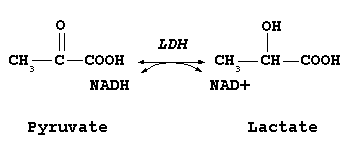Lactate dehydrogenase
|
|
| Contents |
Enzyme isoforms
Every LDH molecule consists of four subunits, where each subunit is either H each M (based on their electrophoretic properties.) There are, therefore, five LDH isotypes:
- LDH-1 (4H) - in the heart
- LDH-2 (3H1M) - in the reticuloendothelial system
- LDH-3 (2H2M) - in the lungs
- LDH-4 (1H3M) - in the kidneys
- LDH-5 (4M) - in the liver and striated muscle
Usually LDH-2 is the predominant form in the serum. An LDH-1 level higher than the LDH-2 level (a "flipped pattern"), suggests myocardial infarction (damage to heart tissues releases heart LDH, which is rich in LDH-1, into the bloodstream). The use of this pheonomenon to diagnose infarction has been largely superseded by the use of Troponin I or T measurement.
Genetics in Humans
The H and M subunits are encoded by two different genes:
- The M subunit is encoded by LDHA, located on chromosome 11p15.4 (Template:OMIM)
- The H subunit is encoded by LDHB, located on chromosome 12p12.2-p12.1 (Template:OMIM)
Mutations of the M subunit have been linked to the rare disease exertional myoglobinuria (see OMIM article), and mutations of the H subunit have been described but do not appear to lead to disease.
Medical use
Hemolysis
In medicine, LDH is often used as a marker of tissue breakdown. As LDH is abundant in red blood cells, it can function as a marker for hemolysis. A blood sample that has been handled incorrectly can show false-positively high levels of LDH due to erythrocyte damage.
Tissue turnover
Other uses are assessment of tissue breakdown in general; this is possible when there are no other indicators of hemolysis. It is used to follow-up cancer patients, as cancer cells have a high rate of turnover, with destroyed cells leading to an elevated LDH activity.
Exudates and transudates
Measuring LDH in fluid aspirated from a pleural effusion (or pericardial effusion) can help in the distinction between exudates (actively secreted fluid, e.g. due to inflammation) or transudates (passively secreted fluid, due to a high hydrostatic pressure or a low oncotic pressure). LDH is elevated (>200 U/l) in an exsudate and low in a transudate. In empyema, the LDH levels generally will exceed 1000 U/l.
Meningitis and encephalitis
The enzyme is also found in cerebrospinal fluid where high levels of lactate dehydrogenase in cerebrospinal fluid are often associated with bacterial meningitis. High levels of the enzyme can also be found in cases of viral meningitis, generally indicating the presence of encephalitis and poor prognosis.fr:Lactate déshydrogénase


